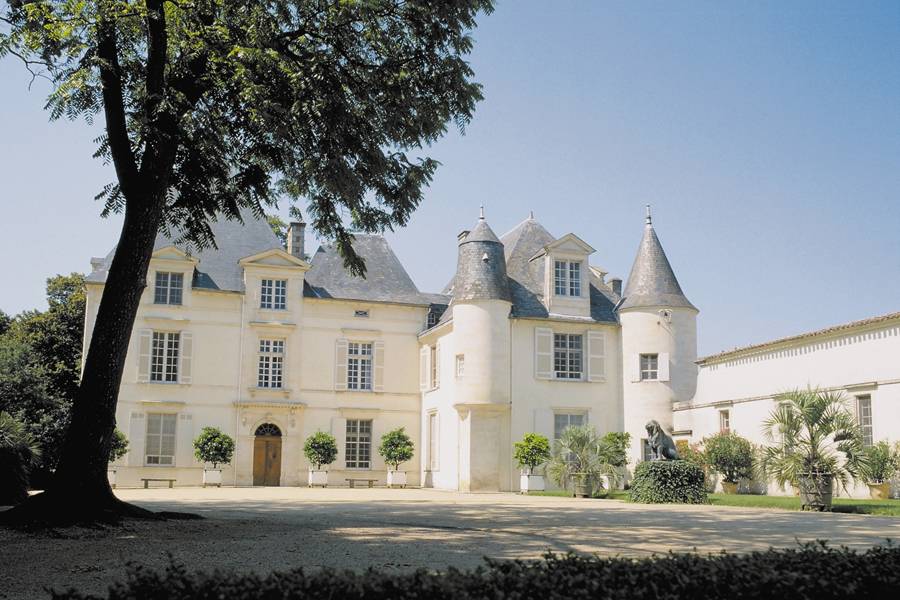- Colour Red
- Producer Château Haut-Brion
- Region Pessac-Léognan
- Drinking 2020 - 2042
- Case size 6x150cl
- Available Now
2002 - Ch Haut Brion 1er Cru Pessac-Léognan - 6x150cl
- Colour Red
- Producer Château Haut-Brion
- Region Pessac-Léognan
- Drinking 2020 - 2042
- Case size 6x150cl
- Available Now
Select pricing type
This wine is currently only available Duty Paid
Need help? Call +44 (0)20 7793 7900 or email wine@goedhuiswaddesdon.com.
-
Goedhuis, April 2003
Ch Haut Brion is always the most appealing and obviously attractive of the first growths when tasted at this stage, and the 2002 is no exception. 51% Merlot, 40% Cabernet Sauvignon, and 9% Cabernet Franc, it has a very different profile to the other first growths, but despite its super stylish, classy structure, it clearly has a powerful structure and enormous potential. The Wine spectator describes it as ‘exceptional wine'.
-
Robert Parker, April 2005, Score: 89
Aromas of minerals, forest floor, fresh mushrooms, plums, and currants are present in the moderately fragrant bouquet. Angular, with hard tannin, medium body, and sweet plums as well as currants, this 2002 is harder and tougher-textured than from barrel. Like many 2002s, it is reserved and angular at present. It remains to be seen whether it will flesh out and reveal more charm and succulence. Anticipated maturity: 2010-2020.
-
James Suckling, April 2003, Score: 95-100
Wow. Super aromas, with blackberries, minerals, currants and licorice. Full-bodied, with an amazing core of fruit and fine tannins. Very long. Exceptional wine.
-
Jancis Robinson, April 2003, Score: 18
Jean-Bernard Delmas thinks this wine is quite supple but I found it the most backward of any I tasted in Bordeaux this spring. Amazingly the dominant grape is Merlot (51 per cent) with 40 per cent Cabernet Sauvignon and the rest, nine per cent, Cabernet Franc. It's thick, dark, blackish purple and still extremely reticent. Dry, sappy, savoury, inky almost monstrous were some of my tasting notes. Enormous in structure. Extremely serious - no tricks or flattery here - I'd guess it will mature much more slowly than most Haut-Brions. There is a certain ripe suppleness on the very front of the palate but that is soon swamped at the moment by the rigour and backbone of all that sappy tannin.Drink 2015-35
-
WK, February 2002, Score: 94
As it closes in on age 20, the 2002 Haut-Brion is beginning to drink very well, opening in the glass with aromas of blackcurrants, plums, cigar wrapper, loamy soil, burning embers and violets. Fleshing out considerably with an hour or two in the decanter, it's medium-bodied, vibrant and concentrated, exemplifying the ideal of intensity without weight, with a deep core of fruit framed by powdery tannins and lively acids. An underrated wine that has rewarded patience, the 2002 Haut-Brion confirms that great terroirs over-perform in cooler, more challenging years. 2020-2045
Producer
Château Haut-Brion
Arguably the oldest recognised Bordeaux grand cru, Haut Brion has been owned by the American Dillon family since 1935. The Château was an early moderniser - the first estate to implement steel vats in 1961 - and over the years, their incredible investments have re-established the inherent quality of this property, enabling it to emerge as possibly the most consistent first growth since the 1980s. Situated in Pessac-Léognan ...Read more
Arguably the oldest recognised Bordeaux grand cru, Haut Brion has been owned by the American Dillon family since 1935. The Château was an early moderniser - the first estate to implement steel vats in 1961 - and over the years, their incredible investments have re-established the inherent quality of this property, enabling it to emerge as possibly the most consistent first growth since the 1980s. Situated in Pessac-Léognan in Graves, the estate is the only classified growth located outside the Médoc. Château Haut Brion has the most Merlot and the most Cabernet Franc of any of the First Growths and the second wine is Le Clarence de Haut-Brion, known as Ch Bahans Haut Brion prior to 2007.Read less

Region
Pessac-Léognan
Stretching from the rather unglamorous southern suburbs of Bordeaux, for 50 km along the left bank of the river Garonne, lies Graves. Named for its gravelly soil, a relic of Ice Age glaciers, this is the birthplace of claret, despatched from the Middle Ages onwards from the nearby quayside to England in vast quantities. It can feel as though Bordeaux is just about red wines, but some sensational white wines are produced in this area from a blend of sauvignon blanc, Semillon and, occasionally, muscadelle grapes, often fermented and aged in barrel. In particular, Domaine de Chevalier is renowned for its superbly complex whites, which continue to develop in bottle over decades. A premium appellation, Pessac-Leognan, was created in 1987 for the most prestigious terroirs within Graves. These are soils with exceptional drainage, made up of gravel terraces built up in layers over many millennia, and consequently thrive in mediocre vintages but are less likely to perform well in hotter years. These wines were appraised and graded in their own classification system in 1953 and updated in 1959, but, like the 1855 classification system, this should be regarded with caution and the wines must absolutely be assessed on their own current merits.




